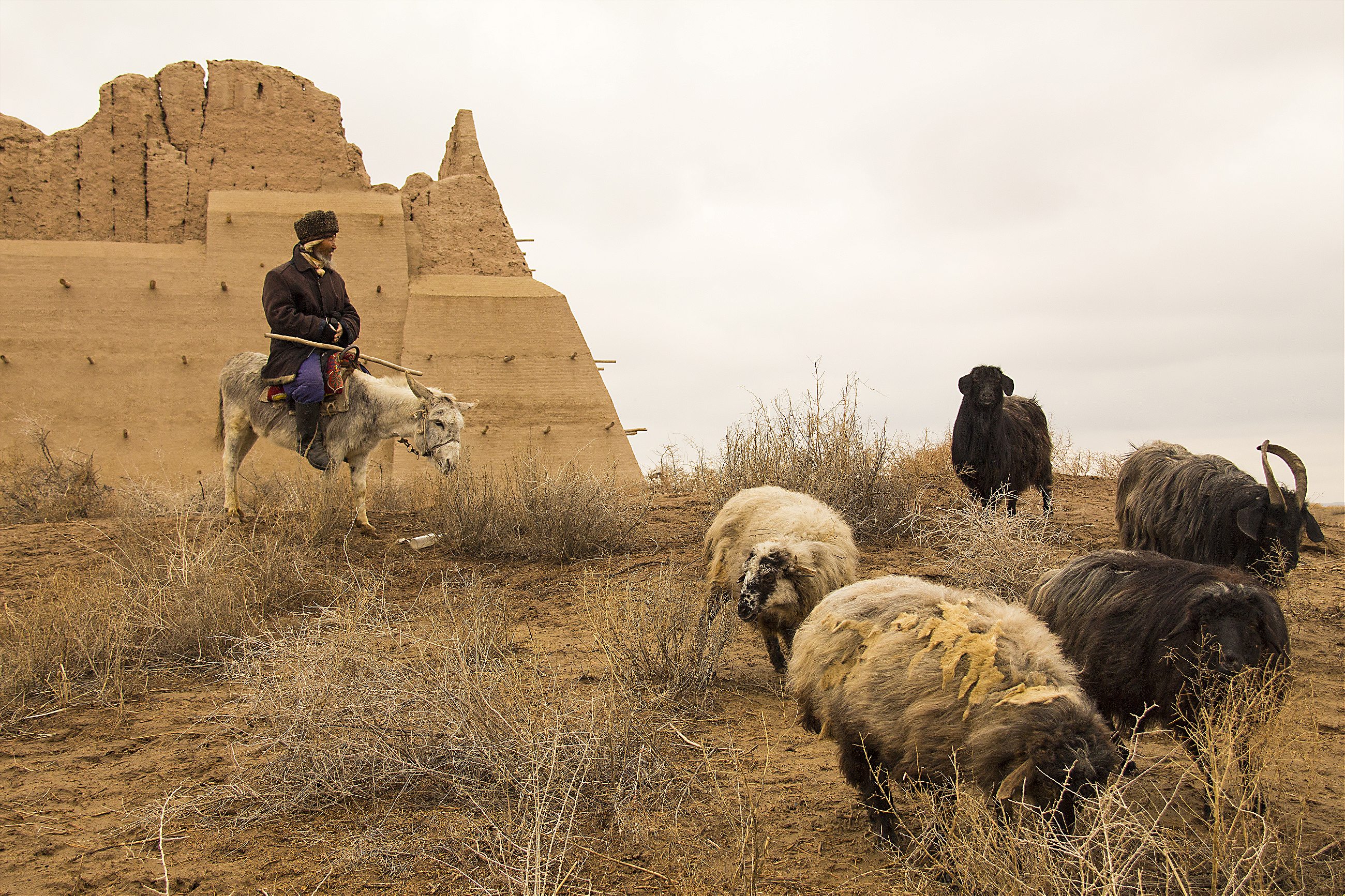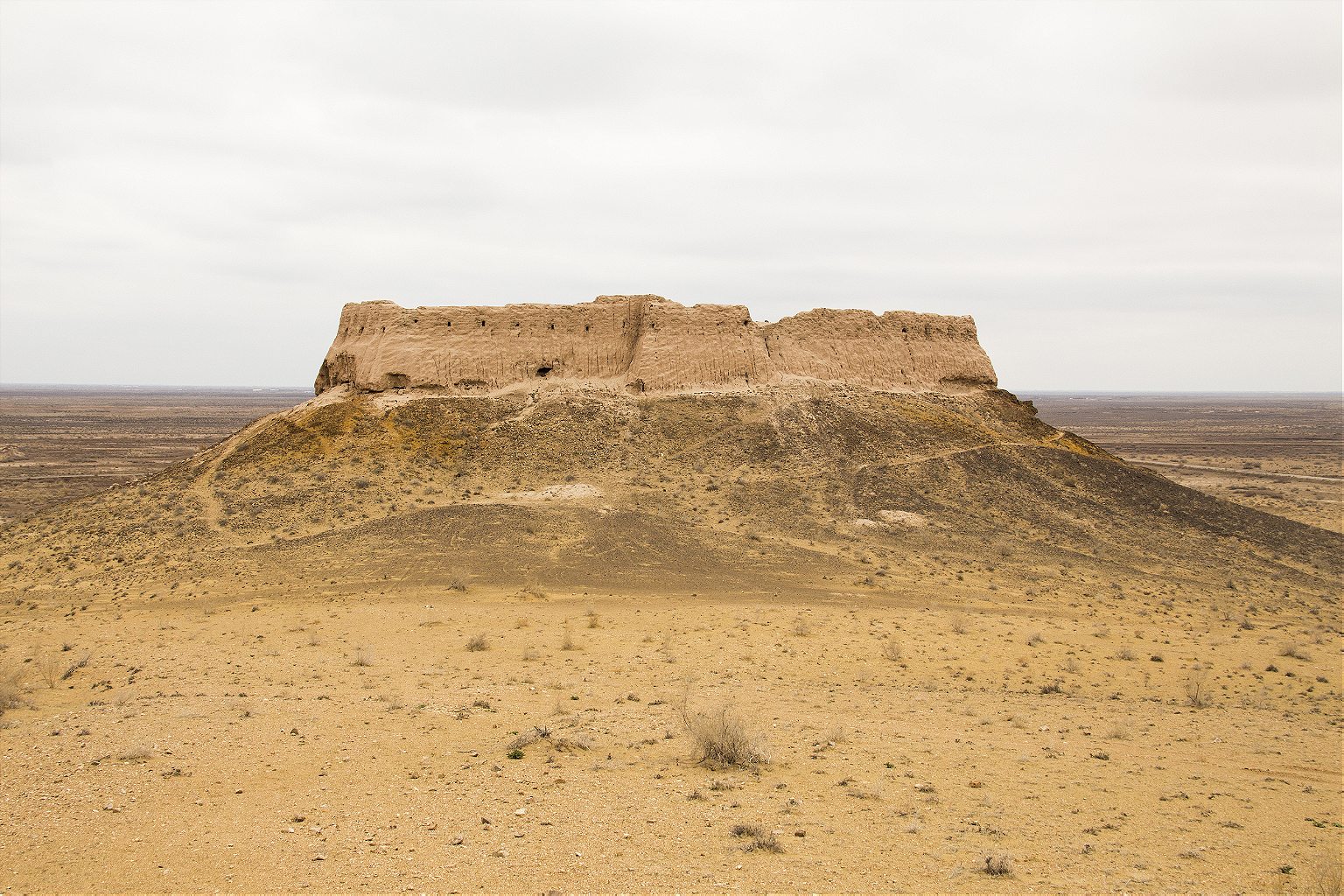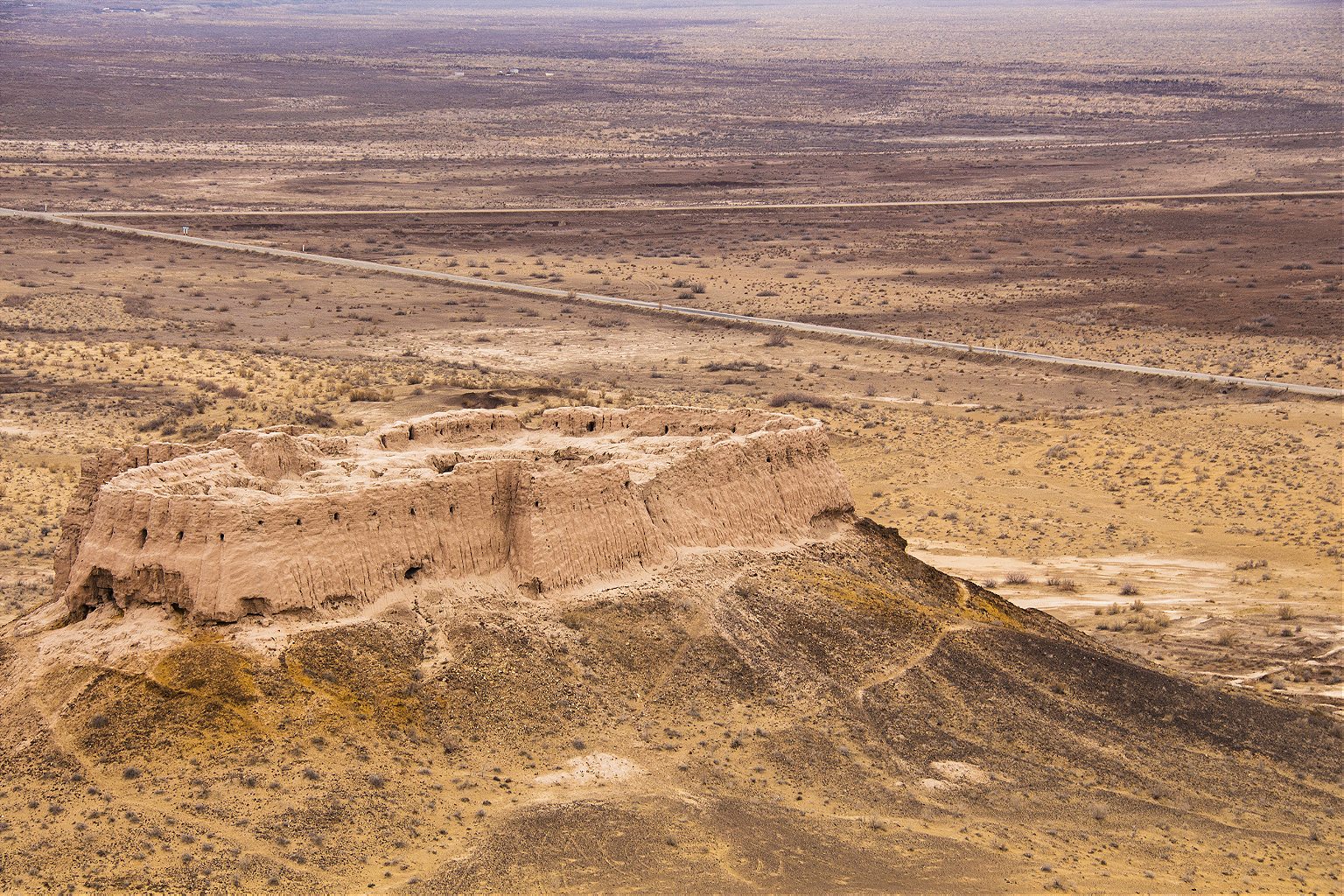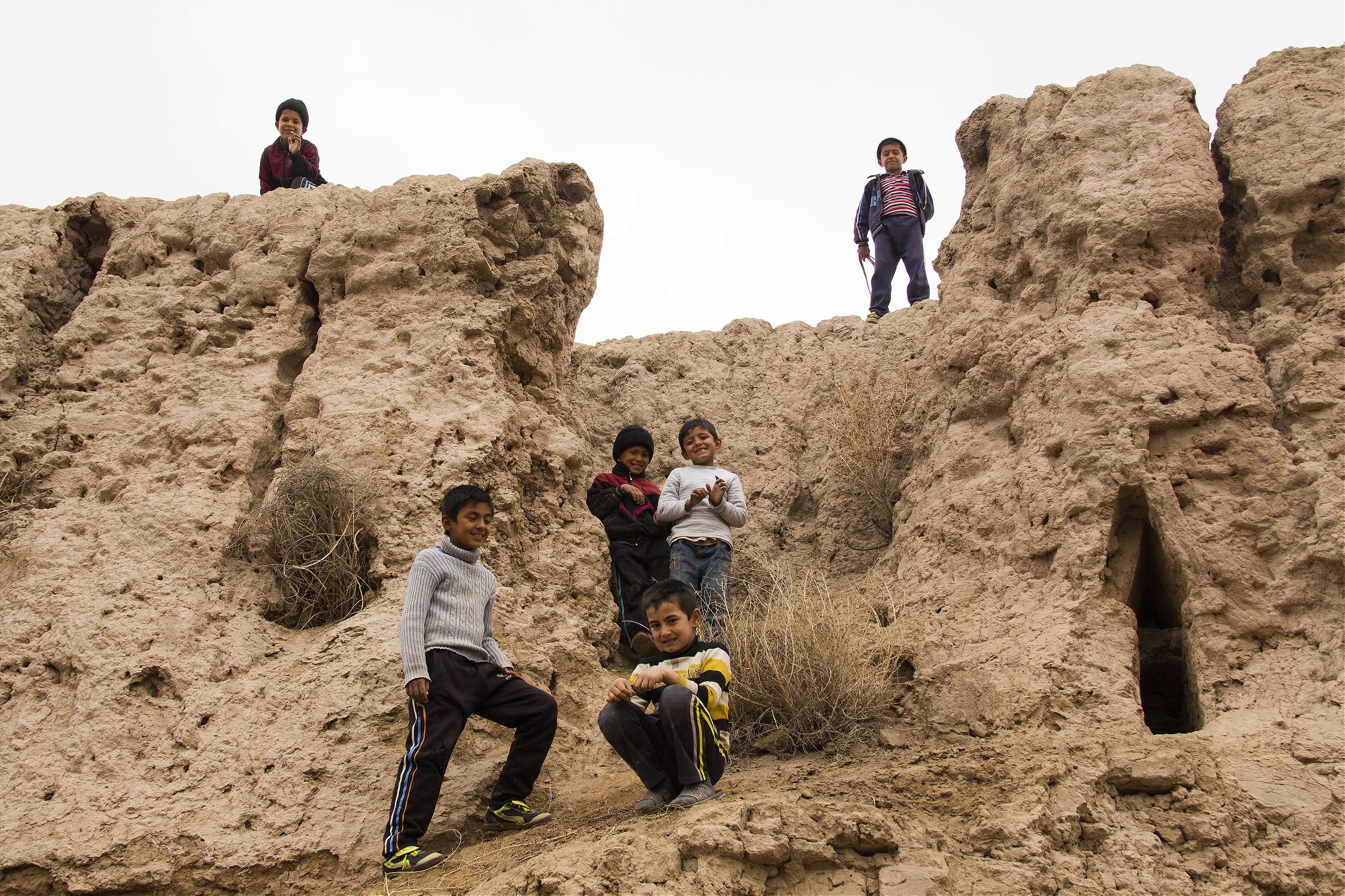Exploring Uzbekistan’s Golden Ring of Khorezm.
We had been driving through seemingly endless desert for 30 miles when Axmad admitted he wasn’t entirely sure where the qalas were. It didn’t bode well for the desert castles, which are seeking World Heritage Site status, that a local driver had never visited them. Nor did it bode well for our chances of finding the structures. There were no road signs and, although we were close, neither formidable ramparts nor crumbling towers jutted out over the land to help guide us to our destination.
Instead, village after featureless village of pre-fab Soviet houses blurred past the window with the air of Levittowns. Except we were around 25 miles outside Bustan in central Uzbekistan, and instead of white picket fences and freshly mown lawns, there were clay bread ovens that smoked like tiny volcanos outside the front doors.
Melon sellers along the road suspended their wares on poles above the ground as our car ker-thunked over potholes. Before long, the villages gave way to hamlets of mud houses. A goatherd guided his flock in search of sustenance by the roadside. They nibbled at the brown grass lackadaisically.
“Nobody visits these places,” said Axmad in reference to the famed castle structures. He scratched the back of his head before replacing his flat cap and pulling in front of three men riding a cart pulled by a robust looking mule. The 61-year-old driver asked a rotund man holding the reins for directions to Kyzyl Qala, one of at least fourteen castles spread along the north side of the Amu Darya river, known more commonly as the Oxus.

The castles form part of what UNESCO has dubbed the Golden Ring of Khorezm. The term refers more to the color of the earth than to the affluence or history of the place. The castles are steeped in mystery and sand rather than jewels and precious metals.
“Right there,” replied the rotund man, pointing across a field. As it came more clearly into view, Kyzyl Qala looked modestly magnificent; plonked in the middle of the maize field and surrounded by irrigation channels as though somebody had misplaced it. A row of poplar trees led up to its aged mud walls, which speared the sky like jagged, broken teeth.
A sand road to the qala looked all but impassable, especially to Axmad’s ramshackle Daewoo Nexia, but he gunned it over the humps and hillocks with expertise and we arrived at the foot of the qala.
Kyzyl Qala was originally built around the 1st century CE as an auxiliary fortress to the main township of Toprak Qala, which was visible across the fields a mile away. It is thought that Kyzyl Qala was used as a military garrison, while Toprak was the main town where commerce and religious activities took place.
Axmad took a brief look at the castle, then decided to wait in the car. “There’s nothing to see, it’s just some old walls and lots of sand.” The original walls were in a sorry state. The mud bricks, although compact, hadn’t weathered well. The walls were buttressed around their base with a modern wall to keep them upright. Arrow slits still pock-marked the sides.

Mongols were mostly to blame for the destitution of Kyzyl and all the other qalas in the region. The current remains of Kyzyl castle belong to the version constructed in the 12th century, when the important Silk Road caravanserais and trading posts, hugging the Oxus to avoid the Kyzyl Desert to the north, were at the height of prosperity.
Then, in the 13th century, Mongols swept through the area. By the time their empire had reached its end a century and a half later, the sand castles in Khorezm were in ruins and the Silk Road, largely closed for business during this time, had started to be replaced by ships as a preferred method of trade and transportation.
Getting into Kyzyl Qala involved a scramble up a hardened sand bank through a gap where the wall had fallen in. Sand storms had deposited layers of sand inside the fortress over the centuries, which was packed and baked hard like cement. In this way, the interior floor was almost as high as the tops of the walls. Saxaul had taken root. Holes in the sand, formed by draining rain water, suggested that an excavation would reveal lower levels, buried below.
Why bother building a castle if it ends up like everything else?
Clambering back down out of the castle, I noticed some goats had meandered over while the goatherd calmly watched on. “What are you doing here?” he asked out of curiosity, rather than suspicion. It was odd but it seemed as though visitors were not common here. Before waiting for a response, he said, “There’s treasure in there, you know.”
I asked him if he had tried to look for it. He stared off to the horizon. “Nobody can get it, it’s guarded by a serpent,” he said, returning his gaze to the ruins. “I don’t need it anyway. We live simple lives here. Why bother building a castle if it ends up like everything else?” Noticing his flock had ambled on, he spurred his donkey and moved away.
Revving the engine, Axmad made it clear it was time to leave, and we pressed on towards Ayaz Qala, a cluster of three separate forts. Visiting them now, it is a wonder why anybody would be interested in conquering the surrounding land. Over time, the compact sand of Kyzyl Qala has been replaced by the shifting sands of the Kyzylkum desert, out of which Ayaz Qala rose as we drew nearer.
Today the autonomous republic of Karakalpakstan, one of Uzbekistan’s most impoverished regions, encapsulates the Elliq Qala castles (as they are also known) of ancient Khorezm. The castles weren’t originally surrounded by desert, although the desert was always close by.


The land had been long nourished by the Oxus. When the Soviets initially expanded the system of water channels around the river for irrigation, it was a success. Then they got greedy; Soviet cotton production targets overstretched the river. The Aral Sea, fed by the Oxus over 200 miles away, dried up.
Those water channels didn’t reach as far as Ayaz Qala anyway, so the ensuing depletion of the river welcomed the desert back in. The castle, on a hill, overlooks nothing but desert.
Few live in the region now. On the day of our visit, the ruins of an abandoned farmstead were being investigated by a camel. Wind-driven sand rippled an untrodden path up to the fort, whose walls were first constructed in the 4th century BCE. In places they still stood 30 feet high. Arched galleries, now filled with sand and impassable, ran the entire way around the interior of the qala.
Despite the sand’s omnipresence there is a subtle beauty to the landscape. The contours of the land took on different hues depending on how the light hit them, so that the ocher foreground blended to sienna, then mauve and eventually violet. Such was the isolation that sounds from far away took on a surreal quality. The grunt of a camel somewhere was distorted into the metallic scrape of a sword replaced into a scabbard. A car horn in the distance became the bugle call of an approaching army.
The wheezing prattle of shelducks could be heard long before they were seen as I got my first look at the second fortress. Sat atop a lower rocky outcrop, its walls were more complete, and much thicker. An impregnable citadel. Two ruddy shelducks were perched atop the walls. Another two scudded across the desert backdrop, their black wingtips tinged with green. On the road beyond, Axmad caught sight of me and beeped his horn again.

It wasn’t until visiting the final qala that Axmad appeared genuinely intrigued by what we saw. Guldursun Qala was only a few miles from where he had grown up. After asking for directions from a melon seller, we found Guldursun above a small agrarian town, which lapped at its lofty walls. Most of the houses were built of mud bricks, with corrugated iron roofs.
Not a single structure remained inside the high castle walls, just scrubland with a small pond in the middle. Axmad raised his hands. “See there is nothing here,” he told me. “What use are these places to us now if nobody comes? They’re pointless.”
His frustration is understandable. Modern Uzbekistan remains a relatively unknown entity as a tourist destination. Organized groups visit Silk Road gem cities like Bukhara and Samarkand, but there is little independent tourism.
This may be about to change. Islam Karimov, the autocratic ruler who had run the country since the fall of the Soviet Union, died last year. His successor, Shavkat Mirziyoyev, has begun to open the country up. He attempted to change visa laws so that travelers from many countries, including the U.K. and anyone from the U.S. over the age of 55, can get a visa on arrival. Due to the country’s stodgy bureaucracy, these changes have been postponed and may not come into effect until 2021.
Karimov was not so friendly to outside interests. While reliant on UNESCO to save the fortresses, NGOs have not always had an easy time of things in Uzbekistan.
Fierce international criticism to the brutal suppression of protests in Andijan in 2005, in which hundreds were believed to be killed, led the Karimov government into knee-jerk retaliation. Western organizations like the UNHCR branch in Uzbekistan and the BBC World Service were kicked out of the country. It was a huge setback for the preservation and international showcasing of the Golden Ring of Khorezm.
Guldursun Qala reveals a lot about a fascinating period of Khorezmian history. Besides trade goods, ideology also passed along the Silk Road. Muslim armies ushered in a new era of faith-driven power in the 8th century and Khorezm became a vassal of the Khwarezmshahs, also emanating from Persia. Guldursun Qala was one of their most important settlements in the region.

More than a millennium after its importance had dwindled, voices continued to ring out from the structures during our visit. But it was unclear initially where they emanated from. As I circumvented the walls, the voices came again. They were followed by a small stone that whizzed past my face.
A group of young boys peered out from the jagged ramparts, giggling and ducking only to reappear further along. One boy with a runny nose squealed and leaped from a crumbling tower onto the wall and hoisted himself up.
This was the best-preserved tower of Guldursun Qala. The wall walks and arrow loops remained intact. The interior of a defensive tower still had the slots that would have held wooden rafters at one time. It is now the playground for the local children.
“This is our castle,” one of them said proudly. And indeed, for today it is. But in time they might have to share their sandy playground with greater numbers of tourists, if they can find the castles in the desert. As a passing goatherd noted, “It’s a shame to see such beauty ignored.”
